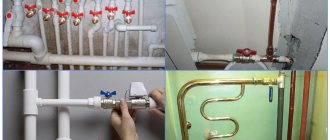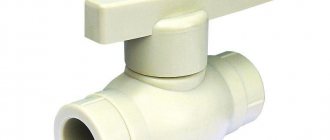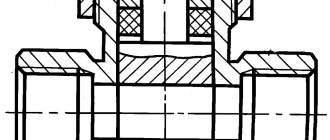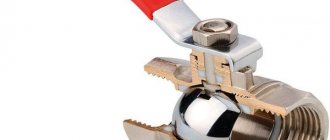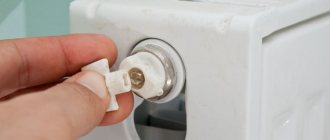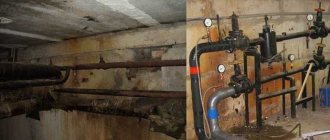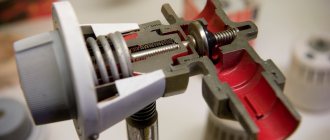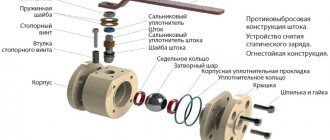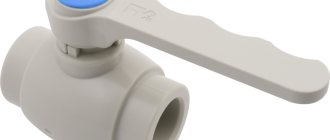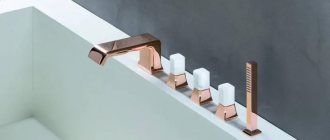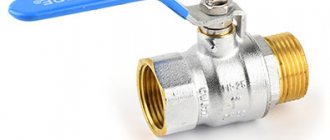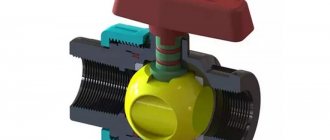Polypropylene pipelines are very popular in the modern market. This is due to the fact that they have a number of undeniable advantages in comparison with their metal counterparts. During the installation of polypropylene communications, you cannot do without special fittings - ball valves, which are used to shut off the flow of the working medium in the pipeline.
Ball valves made of polypropylene are installed on polymer pipelines transporting different types of media
PPR ball valve design
A propylene ball valve belongs to the category of shut-off valves and is not intended for flow regulation. If such a tap is used for adjustment, it quickly loses its performance characteristics due to the formation of cavities.
One of the most striking features of PPR valves is the absence of a seal on the stem. The sealing elements, although present, are located in a completely different part of the structure - outside the through hole, in the seat part. It is made from synthetic rubber.
The position of the unit is fixed by two polymer limiter rings, which are located on the sides of the ball locking element. The device itself is made by casting, which adds strength to it.
The check ball has a round hole on parallel walls. When the flow is open, the hole is parallel to the axis of the pipeline. If it is blocked, the lever turns the ball so that the throughput pipe is blocked by the monolithic walls of this ball.
The handle can be in the form of:
- lever;
- butterflies.
Technically, the principles of their operation are no different. The faucet is fixed using a hexagon connection and a special rivet, which is called a “cut-off” rivet.
Attention! If the seal of a plastic tap is broken, it is not repaired, but completely replaced.
If the seal of a plastic tap is broken, it is not repaired, but completely replaced.
Selection of locking products
If you have no experience in carrying out plumbing work, then it is better to use the services of a specialist. This also applies to the choice of system components.
When purchasing, pay attention to:
- Shop. When it comes to heating and water supply at home, the materials for constructing the system should be purchased in specialized stores. Consultants will help you choose a model.
- Price. This factor often becomes decisive when choosing materials and components. Many people buy cheap models. But they are short-lived and do not function fully. Therefore, you should not save, otherwise problems with the performance of polypropylene pipes and shut-off valves cannot be avoided.
- Condition of the case. Before purchasing a unit, you should carefully inspect its housing. It should not have cracks, chips or other defects. If there is damage, the service life of the product will be reduced.
- Manufacturer. It is better to purchase models from well-known companies that guarantee quality. Certificates indicate this.
- Dimensions. The diameter of the connecting pipes must correspond to the cross-section of the pipes. Otherwise, connection problems will arise when laying the pipeline.
- Installation location. The tap or valve should be installed in places where it is possible to freely control the locking mechanism.
Plastic products are cheaper, but not durable. As an alternative, choose models with a metal locking element.
We recommend reading: Polypropylene pipe 50 mm is one of the most popular polymer products.
Its purpose and technical characteristics
The main documents that define the technical characteristics and application of spherical polypropylene structures are two international standards - ISO No. 15774 and DIN No. 16962. In accordance with them, the main area of use of this design is heating systems made of plastic pipes, with coolant at 90 degrees and water supply. It is prohibited to use such taps if the coolant temperature is one hundred degrees or higher, or if we are talking about a gas pipeline.
The standards also allow the use of PPR valves in some other types of technical pipelines. We are talking about systems for the following types of industry:
- chemical;
- pulp and paper;
- food;
- pharmaceutical
But here, too, the temperature range plays a big role for a simple reason - plastic is destroyed in a hot environment.
There are also restrictions on the size of pipes on which polypropylene devices can be installed. They can have a diameter from 23 to 63 mm. Their general technical characteristics are as follows:
- Constant maximum temperature of 90 degrees with short-term increases to 110.
- The service life is from 25 to 50 years, depending on the systems in which they are used (heating or hot water supply, cold water supply).
- The pressure in the system should not exceed 20 bar.
Important! Polypropylene ball valves lose their tightness at 130 degrees Celsius.
Polypropylene ball valves lose their tightness at 130 degrees Celsius.
Crane characteristics
The combination of low cost and excellent technical characteristics makes polypropylene one of the most popular materials for use.
Advantages:
- Low cost, therefore, production is much cheaper than similar products made from other materials.
- Light weight.
- Corrosion protection.
- Service life is about 50 years.
- The operating range starts at -10 °C and ends at 95 °C.
- No electrical conductivity.
- Environmentally friendly material, harmless to people and the environment.
We recommend that you read: Scissors for cutting propylene pipes - types and technology of application
There are few disadvantages of polypropylene products, but they are present:
- The material is flammable. Accordingly, it should not be used near an open flame, for example, near a stove.
- Use at temperatures below -10 °C is not recommended; in rare cases, the material can withstand up to -20 °C. At low temperatures, polypropylene becomes brittle and unstable to mechanical stress.
- At temperatures above 95 °C, PP products wear out quickly.
Advantages and disadvantages in comparison with brass analogues
The main competitors of polypropylene devices today are brass. They are valued because they can withstand twice the pressure and operate at 150 degrees. The main advantage of brass products is their maintainability. Unlike plastic systems, in the event of depressurization, some parts must be replaced.
As for the disadvantages of brass devices, the main one is cost. They are several times more expensive than polypropylene ones, while at the same time the latter are so cheap that the question of repairing them will not even arise for purely financial reasons.
But price is not the only advantage of polypropylene ball valves. The list of positive qualities includes:
- They are resistant to chemical influences - be it corrosion or chemicals. They do not suffer from the appearance of plaque.
- They are installed very simply and correspond to standard sizes of small diameter pipes.
- They are quite durable if you follow the operating conditions.
- They weigh extremely little.
- They do not stand out against the background of plastic pipes.
As can be seen from this list, it makes sense to give preference to brass devices only in the sense that sufficiently hot substances are supplied through the pipeline.
Purpose
The definition of “ball valve” is equally applicable to a water tap and a valve. These two types of cranes are distinguished by location and purpose. The water tap is the end point of the water supply; the valve is installed between the elements of the water supply.
Ball valves for water supply are designed to completely shut off the main line or to regulate the flow. In shut-off valves, the design provides for two operating positions “closed” and “open”, excluding intermediate ones. To reduce the water supply, redirect the flow or mix two flows, ball valves of a different design are used, which are specially designed for these purposes.
A ball stop valve is installed on water pipes:
- for each branch of wiring to household appliances (water heater, washing machine, dishwasher);
- for each water supply line leading to the sink, bathtub, shower;
- for an individual outlet from the main water supply line (for introducing a water supply system into an apartment or house).
The installation scheme of an internal water supply system with the installation of a shut-off device on each section of the distribution somewhat increases the cost and complicates the installation of communications, but in the long term it is more profitable. In the event of a pipe break or failure of any household appliance, a ball valve allows you to quickly shut off the water supply to the problem area. At the same time, residents still have the opportunity to use running water.
A water-folding ball valve is installed separately for cold or hot water, and is also a common type of mixer. A ball mixer is a valve that is opened and closed not by rotating a knob, but by a lever, turning it left and right to adjust the temperature and up and down to control the flow force.
Ball valves are used in classic individual heating systems and when installing heated floors. Shut-off valves allow you to isolate individual radiators from the main system, thus regulating the temperature in the room. In the event of a radiator breakdown, this allows you to avoid stopping the heating operation for repairs.
The choice of shut-off valves for a heating system is limited by certain requirements for temperature and internal pressure. Not every ball valve is suitable for this due to its operational characteristics.
How to install a polypropylene tap
Installation of polypropylene taps is simple. To do this, use socket welding or special adapters.
In order to install the faucet yourself, you first need to prepare the tools:
- chamfer;
- soldering iron with special heating nozzles corresponding to the diameter of the pipes;
- plastic scissors;
- calibrator
First, heat the soldering iron to the required temperature, which is at least 240 degrees. While the soldering iron is heating, the pipes are prepared. To do this, they are cut, then, using a calibrator, they are returned to their original shape and the burrs are removed with a chamfer.
When the soldering iron has heated up, put a pipe and a pipe on the nozzle. Depending on the diameter, the product heats up in no longer than 12 seconds (time for a 40 mm pipe). As soon as the tap and pipe are heated, they are connected to each other. The pipe is inserted into the socket until it stops and fixed motionless for 4 minutes.
Important! Under no circumstances should joints be cooled with cold water.
Under no circumstances should joints be cooled with cold water.
Procedure for soldering polypropylene elements
When all the necessary tools and materials have been prepared, you can proceed to the task. It is divided into two stages: preparatory and direct soldering of fittings for polypropylene pipelines. First of all, you need to prepare a place to work.
The welding machine kit includes a special clamp. It is used to secure the machine, for example, to a table. This mount is very reliable, the device will not wobble. Therefore, it will be convenient to work with him. But in some situations, soldering is performed not at the workbench, but directly next to the water supply. In such a case, the machine has a handle for holding it in weight.
What do experts advise?
Unfortunately, despite the simplicity of the connection technology, errors are common during installation. In order to avoid them, experts advise strictly monitoring and avoiding the following situations:
- preservation of contamination at the contact points between the pipe and the tap, due to which the quality of the connection deteriorates;
- incorrect position of the elements when connecting - there are only a few seconds to correct any deficiencies in positioning until the plastic begins to set;
- removing melts immediately after joining, without waiting for the plastic to completely harden - otherwise deformation may occur;
- the presence of a gap between the valve body and the fitting - in order to avoid such a situation, it is necessary to press the end of the device into the pipe until it stops;
- the formation of internal flow, which can occur when excessive force is used - otherwise the throughput hole will decrease.
Eliminating these errors will allow you to achieve maximum tightness and durability of the connection between the tap and the pipeline.
Installation
You can install the ball valve yourself. To do this, you need to choose the right part in the store and perform a number of actions. Installation recommendations:
- Select parts depending on what thread is applied to the pipes. The same goes for diameter.
- Place the crane so that the movement of the handle is not interfered with by other objects.
- Threaded connections must be wrapped with FUM tape. It will ensure reliable tightness at the joints of parts. When twisting the element, it should move with force. If it turns easily, you should add a few turns of tape.
- If the connection is permanent, you need to use a special soldering machine to make it. It heats up to 260 degrees and has attachments for different diameters.
- Use a calibrator to remove any unevenness after cutting the pipes.
Installation steps:
- Mark connections.
- Connect the soldering machine to the network, wait for it to heat up to 260 degrees. Many devices have a light that will go off once it has fully warmed up.
- Clean the joints from dirt and burrs. Degrease them with alcohol and wait until completely dry.
- Place the ends of the pipes onto the heated nozzles. Wait 4 seconds.
- Insert the heated end of the pipe into the tap until it stops. Do not press too hard to avoid internal plastic buildup.
Do a test run of the fluid to check the tightness of the connection. If there are no leaks, you can safely use ready-made water supply
When carrying out work, it is important to constantly check how evenly the pipeline elements are positioned among themselves. Displacement leads to leakage
When installing a locking device on a threaded connection, do not clamp the parts too tightly. Excessive twisting can lead to thread damage. If the liquid does not leak during the test, you can begin operation.
Pipelines are installed in any residential building. They are needed to supply water and gas to the premises. To block the flow of liquid, you need to install a special part.
Ball valves or gate valves - which is better?
When choosing shut-off valves, the following must be considered. A polypropylene faucet can operate without interruption for several decades. According to the statements made by the manufacturers of these products, they can last up to 50 years. Cone valves differ from them in that scale is concentrated on the surface, and you can be sure that this scale will sooner or later become an insurmountable obstacle when closing or opening the valve. In addition, it is impossible to compare the overall dimensions of ball and cone products. And yet, cone valves require regular inspection.
Basic parameters and design features
Each ball valve model has its own basic parameters. For example, taps made from PPRC propylene can operate in any environment. The maximum pressure for which these taps are designed is 20 MPa, and the maximum temperature can reach 95 degrees Celsius. You must understand that valves made of this material can operate at maximum pressures of up to 75 MPa.
The polypropylene faucet includes:
- a body with a handle installed in it;
- a valve in the form of a ball made of corrosion steel with a hole equal to the working diameter of the pipe on which it will be installed;
- several seals, etc.
Some valuable tips
When choosing a polypropylene faucet, you need to remember a few simple things:
- the thread on the valve body must match the thread on the pipe;
- purchasing a used valve can lead to leaks, with all the ensuing consequences, in the form of flooded neighbors.
- The brand is important. The fact is that many European manufacturers transfer their production to third world countries, but do not always carry out quality control.
It is advisable to invite specialist plumbers to install the faucet. Installing shut-off valves yourself can end sadly. We must remember that the working pressure is up to 8 MPa.
Types and designs
Structurally, almost all ball valves are coupling based on the connection method; there are flanged models of large diameters for industry.
Differences
Plastic fittings differ from their steel and brass counterparts - they cannot simply be screwed onto the threads on the pipe. For its installation, completely different design and technological solutions are used.
There are the following types of PVC ball valves:
- with couplings for adhesive joints - the coupling has an internal diameter equal to the external diameter of the PVC pipe;
- with internal thread in connecting pipes;
- corner;
- membrane valves (designed for installation in systems for transporting very contaminated media);
- with a pipe for glue on one side and a pipe for a threaded connection on the other.
The marking of ball valves of any production complies with GOST 52760. The marking includes the nominal diameter (nominal bore) - DN + numbers; nominal pressure indicator PN, operating pressure value, maximum operating temperature.
Marking
Ball valves for heating systems have a numerical and letter designation:
- KSh - ball valve.
- Letter designations: M (coupling), F (flange), Ш (fitting), P (through).
- Letter designation: E (electric drive), Pn (pneumatic drive), if there is no designation - manual control.
- DN ХХХ - passage diameter. For example, DN 1 (1/2) inch.
- PN XXX - working pressure.
- XX - characterizes the model in terms of resistance to the working and environmental conditions.
After reading the label, you can easily select the required option.
When purchasing, you should pay attention to the following indicators:
- Passage diameter. The peculiarity is that the taps have an internal size designation. If the parameter is 1 (1/2) inch, then a pipe with a passage of 40 mm or an outer diameter of 46 mm will fit it.
- Operating pressure. For heating systems, a parameter with a margin is always selected. Recommended value from 20 bar.
- Manufacturer. It is recommended to give preference to Russian or European manufacturers. Chinese production uses silumin for such devices, which is not reliable and resistant to aggressive environments.
- Case material. Brass products are considered the most reliable. They are recommended for heating systems. There are many fakes on the market, so you should request a certificate for the product. And also study the appearance of the product. If there are sagging or other visible defects on it, this should alert you.
- In the internal space, consider the locking ball. If it has a smooth mirror surface without defects, then this is a guarantee of long service.
- Price. Ball valves for heating, the price of which is significantly lower than the market average, will most likely also turn out to be a low-quality fake. Their cost starts from 500 rubles.
- Handle material. It is advisable to choose metal. Plastic is a fragile material and deteriorates over time.
- Check the locking mechanism. It should close and open without much effort.
When something happens in the house, it is necessary to turn off the water as quickly as possible. In the old days, to do this, you had to run to the basement and shut off the entire riser, and only a house management mechanic could do this. And all the time while he was slowly getting ready and going to fix the accident, the “victims” had to fight the flow of water on their own, risking flooding their neighbors.
In order to avoid such situations, it is necessary that in each apartment there are valves on the branches from the main risers, allowing you to instantly turn off cold and hot water at any moment. What kind of shut-off valves should be used for this?
